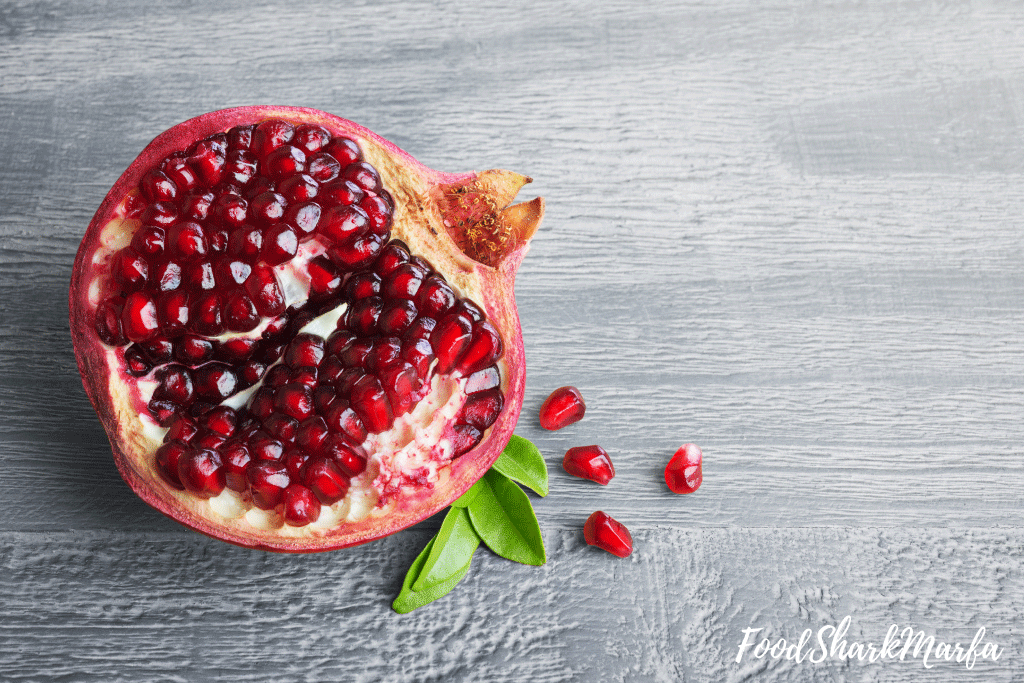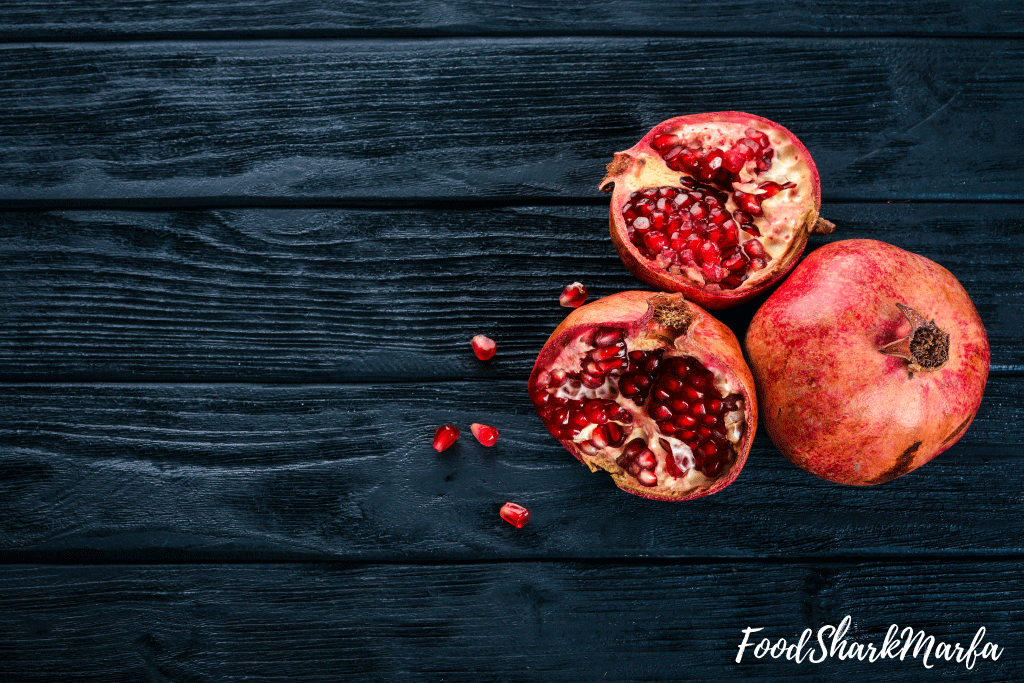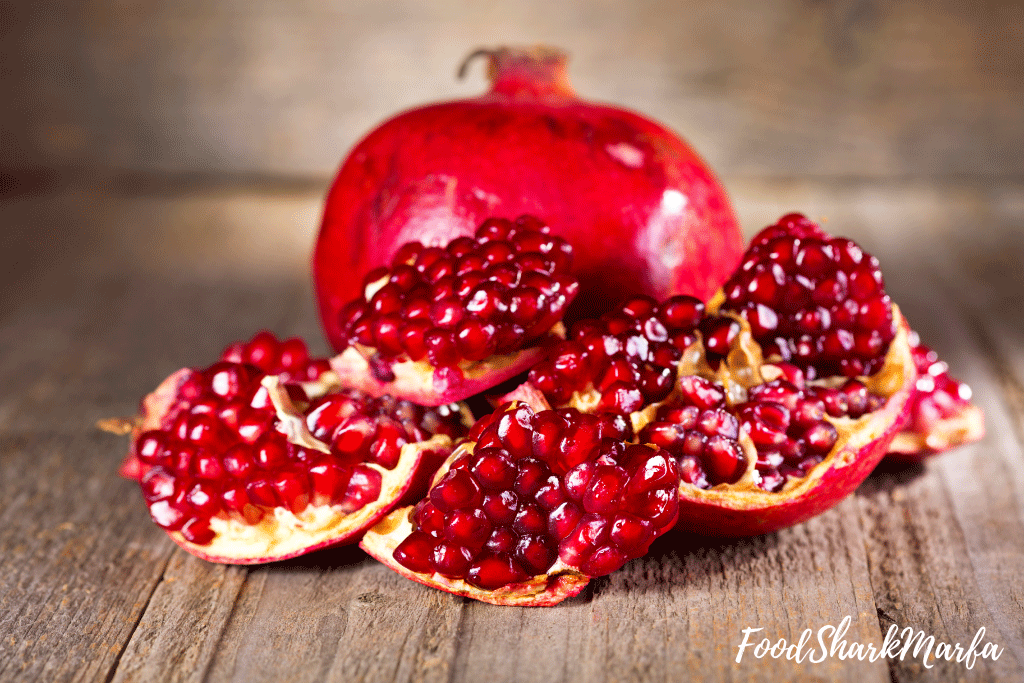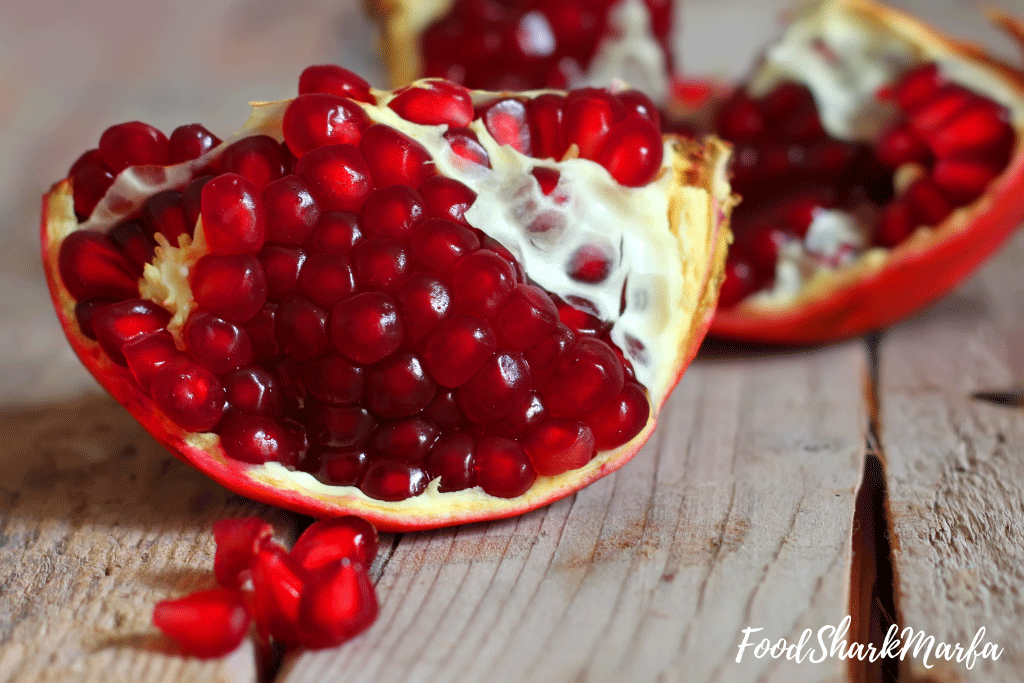The answer to the question of can you freeze pomegranate seeds, is yes, you can freeze pomegranate seeds successfully, along with fresh pomegranate juice. As whole pomegranates are not usually suitable for freezing, you will need to cut open the pom and remove the seeds (or arils) to freeze them individually.
As well as adding to breakfast cereals, salads, risottos, curried rice, desserts, fruit cups and more, pomegranates bring flavor to a range of summer delights such as jellies and puddings as well as of course, grenadine, the popular cocktail mixer.
All About Pomegranates or ‘Seeded Apples’
The name pomegranate (Punica granatum) means ‘seeded apple’ in medieval Latin and in early English, the pomegranate was called the ‘apple of Grenada’. This ‘apple of Grenada’ can still be seen on some coats of arms and flags that date back to medieval times.
The French name for pomegranate is grenade, which not only gave its name to the military grenade, but also the grenadine mixer.
Pomegranates are typically available September to the New Year in the US, with the prime season being October to November. The most common varieties available in the US are red pomegranates, although white, pink or other varieties may be found at farmers markets or specialty stores.

Pomegranates grow on a shrub that can grow up to 33 ft tall and live for as long 200 years. Originating in the Middle East and across to Northern India, pomegranates were cultivated in the Mediterranean region in ancient times. When Spanish settlers moved to the New World, the pomegranate went with them.
The pomegranate has long been a symbolic fruit in many cultures and religions. Ancient Egyptians considered pomegranates to be a symbol of prosperity and ambition and bizarrely, they were also used as a treatment for tapeworms! The Ancient Greeks considered that the pomegranate had sprung from the blood of Adonis (the god of beauty and desire) and was given the name of ‘fruit of the dead’. In ancient Greek mythology, pomegranate seeds were also linked with Persephone - the goddess of the underworld - and her abduction by Hades, the god of the underworld.
Pomegranates still feature in world religions, they represent resurrection and everlasting life in Christianity, and they are fertility symbols (and more) in Judaism, Islam and Buddhism.
Today, most of our pomegranates grown domestically come from California and Arizona. Globally, they continue to be grown in the Mediterranean, parts of Africa, the Middle East and parts of Asia.
Although we know pomegranate seeds as seeds, they are actually called arils. The aril contains the small white seed – which some of us may spit out – surrounded by the pink flesh and these arils are attached to the white membrane or pith. The rind and the pith of a pomegranate can be eaten and have been used for medicinal purposes, but as they taste very bitter, you may just want to keep with the seeds!

What Should You Look for When Buying A Pomegranate?
Before a pomegranate ripens, it has a tight and hard rind or skin that does not scratch easily. As the pomegranate seeds develop to the point that they contain the most juice, they start to push the outer rind of the pomegranate out of shape, making it look flattened on the sides. At the same time, the color of the rind darkens to a deeper red or red-brown. If a pomegranate is allowed to mature for longer, then the rind will start to crack.
Once pomegranates are harvested, they do not ripen any further, which is why they are picked ripe. Although they do not ripen further after harvesting, the flavor of them will continue to develop during storage.
When you buy pomegranates look for those that have glossy and taut rinds that are free from heavier blemishes or cuts. If you can pick them up, choose those that feel heavy for their size, as the heavier they are, the more juice they will contain.
When you cut into the pomegranate, the seeds should be rich pink, juicy and plump. A few seeds can be mushy or brown, even if the rest are good, so it is fine to just remove these. If, however, all the seeds have turned to mush or are slimy, then the pomegranate is past its best and should probably be trashed. Any evidence of rot, or unpleasant odor also means it should be disposed of.
How Long Will A Pomegranate Keep in The Refrigerator?
Whole pomegranates will keep in a cool, dark, dry and well-ventilated place for a couple of weeks, or you can store them in the refrigerator for up to two months. If you have de-seeded the pomegranate, then the seeds, or fresh pressed juice will keep for up to five days in the refrigerator.
How Do You Freeze Pomegranate Seeds?
Although the seeds (and fresh juice) can be stored in the refrigerator, freezing not only extends the life of pomegranate, it also helps the seeds keep their flavor and color.
If you are new to extracting pomegranate seeds, or are planning on doing a number of them, you may find an apron and plastic gloves can help keep some of the mess down as well as minimizing the risk of staining to your clothes and skin. It can also be helpful to use a plastic cutting board rather than wood, to again, reduce staining.
There are different ways to extract the seeds, but this is probably one of the most common ways and to do this, you will just need a cutting board, sharp knife and a bowl.
First, using the knife, take off a small slice of the bottom of the pomegranate so that you can stand it up safely on the cutting board. Then, you need to take a circular slice off the top (known as the blossom or crown) of the pomegranate. You may find a paring knife more helpful here.
After sitting the pomegranate on its cut bottom on the cutting board, use your knife to cut from top to bottom around the rind (as if you were wedging an orange). If you can see or feel ridges in the rind of the pomegranate, then cut along these. Be careful not to cut too deep as you do not want to damage the seeds underneath.
Once you have made your cuts in the rind, hold the pomegranate over a bowl and gently tease it apart with your fingers to expose the seeds.

You can either prise the seeds into the bowl, or if you add water to the bowl, you can work the pomegranate in the water as the seeds will sink while the rind and pith will float. You can then skim off the pith and rind and pour the remaining water and seeds through a colander. Allow the seeds to dry properly if you are freezing them. You can do this by spreading them out on some paper towel on the countertop.
In preparation for the freezing, the next step is to line a cookie sheet with wax paper. When the seeds are dry, spread them out on the sheet. Make sure to spread them out well as if they freeze while touching, they will end up stuck together as a clump. Place the cookie sheet in the freezer for no more than two hours and then transfer the frozen seeds to a Ziplock bag or airtight container. If you use a container, make sure there is around ½" of space at the top, otherwise, leave as little air in as possible to reduce the risk of freezer burn.
Pomegranate seeds will keep at best quality for around 4 to 6 months in the freezer, although you can probably keep them for as long as 12 months without them losing too much of their flavor or texture.
Why Does the Texture of Pomegranate Seeds Change If They Are Kept in The Freezer for Too Long?
If you find pomegranate seeds from last year (or dare I say, the year before that) lurking at the back of the freezer, they will probably still be fine to eat, but, they will have lost more texture and potentially some of their flavor due to chemical changes that take place during freezing.
Pomegranates along with many other fruits and vegetables contain a lot of water. In fact, most fruits and vegetables contain 70% to 90% water and this water is stored in the rigid cell walls of the fruit along with other molecules. This means that when pomegranate seeds are frozen, the water within the cell walls expands and ice crystals form which then rupture the cell walls. As a result, once the seeds are thawed, their texture is altered.
Along with damage from ice crystal formation, freezer burn – or loss of moisture from the surface of the pomegranate seeds occurs. This usually contributes to loss of flavor as the surface of the seeds start to dry out. Unfortunately, however well you do wrap your seeds, freezer burn will develop over time, but in properly wrapped foods, its development is slowed down. Packaging the pomegranate seeds as detailed in the previous section and in packaging labeled as suitable for freezing will help reduce freezer burn.
The changes in fruit from freezing and then thawing is why you may sometimes be served a cold dessert with a ‘fresh’ fruit topping that has not been fully thawed. By not fully defrosting fruits, the difference in texture is not always as obvious.
So, if you do end up leaving pomegranate seeds in the freezer for a long time, if you can use them only partly thawed – such as for topping a cold dessert – then this can help hide texture loss.
Can I Freeze Pomegranates Whole?
Whole pomegranates should not be frozen unless you want to use the seeds for juicing or smoothies. Because pomegranates contain a lot of air and moisture inside them, they can be frozen whole, but when they defrost, due to the reasons above, the seeds will be very mushy and even more importantly, it will be a struggle to try and extract the mushy seeds from them.
Is It Quick to Thaw the Seeds?
When you are ready to use the seeds, just take them out the freezer and leave them on the countertop to thaw. Depending on how many you need, allow 30 minutes to an hour for them to thaw. If you do need them quickly, put the bag or container in a bowl of lukewarm water to speed up thawing.
If you are using them in baked goods or smoothies, you can just use them straight from the freezer, i.e. no need to thaw first.
When thawed, you can store the seeds in the refrigerator for as long as a week in an airtight container.
If you have decided to freeze a whole pomegranate, then this should always be thawed in the refrigerator.
How Nutritious Are Pomegranate Seeds?
A half cup of pomegranate seeds will provide you with around 72 calories and 16.3 grams of carbs - most of which is sugars - along with 3.5 grams of fiber.
Header |
Amount per half cup |
|---|---|
Calories |
72 kcal |
Carbs |
16.3 grams |
Sugars |
11.9 grams |
Fiber |
3.5 grams |
Protein |
4.9 grams |
Fat |
1 gram |
(Source: nutritiondata.self.com)
Pomegranates are also a source of micronutrients. This includes around 48% of our Daily Value (%DV) of vitamin C and 58% of our %DV for vitamin K in our half cup serving of seeds. Seeds also contain smaller amounts of other nutrients such as folate, thiamin, copper and potassium.
The fiber in pomegranates is found in the small white seeds inside the pink flesh, so if you do spit out the seeds when eating pomegranate, your fiber intake from them will be drastically reduced.
Pomegranates are a good source of antioxidants, in fact, they contain around three times more antioxidants than green tea or red wine. Some of the antioxidants are polyphenols and it is these that give the fruit its red color.
Polyphenols are thought to have anti-inflammatory actions and may help reduce some of the symptoms of inflammatory disorders such as arthritis. As inflammation also plays a role in many other disorders such as diabetes, heart disease and Alzheimer’s disease, pomegranates may have some therapeutic potential for these conditions. Although the research into this is still in very early stages, some laboratory findings appear promising.
Pomegranate may be able to suppress prostate cancer cell growth and increase rates of prostate cancer cell death . The men in the research study consumed 8 oz of pomegranate juice a day and their PSA (prostate-specific antigen) levels – a blood marker for prostate cancer – doubled over 54 months, rather than the typical 15 months. The shorter the timeframe for PSA levels to worsen, means a higher risk of death from prostate cancer. It is worth noting though, that the men who took part in this research consumed an otherwise healthy diet.
Along with prostate cancer, pomegranate may also be able to reduce the reproduction or even kill, breast cancer cells. To date, the early research has been carried out in the laboratory, so much more investigation, including human studies will be needed to see if pomegranate may have a helpful role in the diet of those suffering with breast cancer.
One research study in 2015 showed that pomegranate juice along with dates (also a good source of antioxidants) was able to provide protection against the development of atherosclerosis in laboratory cultured arterial cells and mice. The combination of pomegranate and dates was able to reduce oxidative stress in the arterial wall by a third and arterial cholesterol content by 28%.
From this, the researchers concluded that healthy individuals as well as those at high risk of cardiovascular disease could receive benefit from drinking 4 oz of pomegranate juice daily, along with three dates (with the ground pits).
Pomegranate has also been shown to decrease the risk of ‘bad’ or LDL cholesterol forming in healthy men who had a dietary supplementation of pomegranate juice, although other research in this area has been not been quite as positive.
If you take blood thinners such as Coumadin (warfarin), ACE inhibitors or other medications, you should talk with your medical professional though before consuming pomegranate. Because it is a rich source of vitamin K - which the body uses in blood clotting processes - there is a risk that eating too much pomegranate can interfere with the actions of blood thinning and other drugs , reducing their effect on the body.
Because vitamin K is abundant in leafy green vegetables, it should not be avoided completely, instead, it will be about finding the balance, which may mean monitoring the diet for a consistent intake of vitamin K, or your doctor may adjust your medications to take account of your diet choices.
The Bottom Line
As I have outlined in this post, yes, pomegranate seeds can be frozen and if you want to keep them around for longer than their short season, then freezing is the best way to store them so that they retain their color and flavor.
Freezing them properly does require a little work beforehand, but as a positive, it means that when you fancy snacking on some, or making a Shirley Temple, you just need get them out of the freezer and once thawed, they are good to go!
Frozen pomegranate seeds can be used in the same way as fresh pomegranate seeds, such as for juicing, as well as adding them to recipes, topping salads, desserts and more.
I hope that you have enjoyed reading about these truly symbolic fruits that have been revered by many people since ancient times and that if you have yet to try freezing pomegranate seeds, that the guidance I have provided will assist you with the task.
